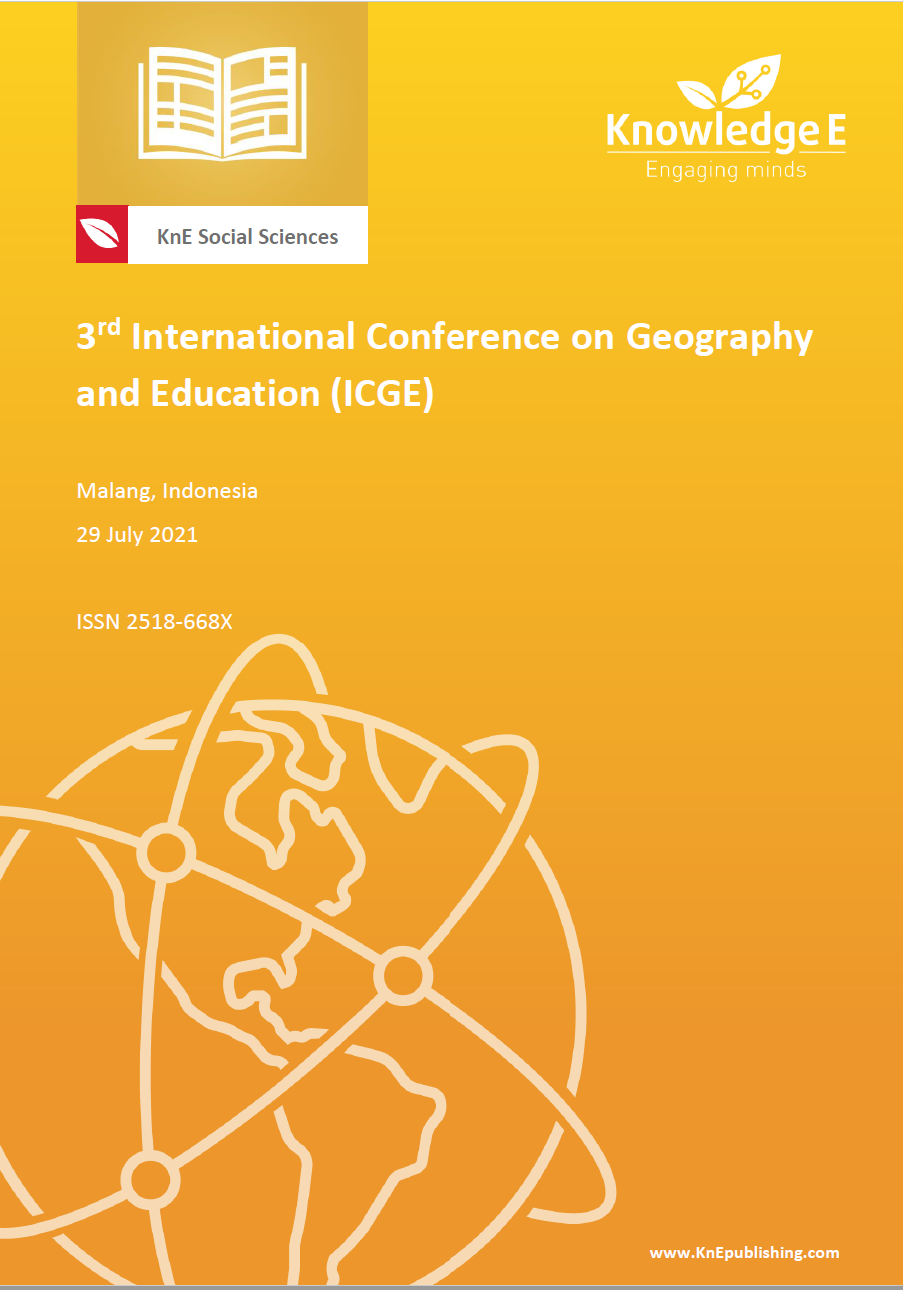No Space at Home: Gender Ideology and Livelihood in Environmental Forced Migration
DOI:
https://doi.org/10.18502/kss.v7i16.12173Abstract
The lives of women who have decided to become Indonesian migrant workers in several Asia Pacific areas, such as Singapore, Hong Kong, Taiwan, and South Korea, provide fascinating research opportunities. This research took as a case study several women from East Java Province who chose to become Indonesian migrant workers due to the loss of agricultural land or plantation fields as their main livelihood. The research analyzed the phenomenon of the migration of women as a result of the environmental crisis, which is a crisis specific to rural areas, as well as the gender ideology that accompanies the phenomenon of feminized labor in Indonesia. This research was conducted with a qualitative paradigm using the snowball technique for recruitment. The research location was in Banyuwangi Regency, East Java Province, Indonesia. The results of the research revealed that in the agricultural sector, which is a source of livelihood, land productivity continues to diminish due to famines, climate change, and land conditions that are not strategic and are progressively narrowed due to industrialization. Instead, land as an agricultural asset can be turned into cost capital for villagers, specifically women, to discover better jobs by migrating as Indonesian migrant workers. In carrying out international migration, the women attempted to alter the gender ideology, transform various negative stereotypes and become empowered and independent female workers.
Keywords: environmental, forced migration, gender ideology, livelihood
References
de Regt M, Lindquist J, Elmhirst R, Killias O. Debate on follow the maid: Domestic worker migration in and from Indonesia. Tot de Taal-, Land- En Volkenkunde / Journal of the Humanities and Social Sciences of Southeast Asia. 2020;176:543- 559. https://doi.org/10.1163/22134379-17604018
Kiranantika A. Perempuan, anak dan keluarga dalam arus perubahan. Anggaunita K, editor. Makassar: Nas Media Pustaka; 2020.
Silvey R, Elmhirst R. Engendering social capital: Women workers and ruralurban networks in Indonesia’s crisis. World Development. 2003;31(5):865-879. https://doi.org/10.1016/S0305-750X(03)00013-5
Fakih M. Analisis gender dan transformasi sosial. Yogyakarta: Pustaka Pelajar; 2010.
Abdullah I. Dari bounded system ke borderless society: Krisis metode antropologi dalam memahami masyarakat masa kini. Antropologi Indonesia. 2014;35(1):36-48. https://doi.org/10.7454/ai.v30i2.3563
Abuiyada RA. Gender, poverty elimination and environmental protection: Three key paths to sustainable rural development. International Journal of Social Science Studies. 2016; 5(1):1-10. https://doi.org/10.11114/ijsss.v5i1.1991
Anggaunitakiranantika M. Indonesia migrant worker: Modern representation of women as Javanese villagers in East Java, Indonesia. International Conference on Rural Studies in Asia (ICoRSIA 2018): 2018 11-12 Okt. Semarang, Indonesia. https://doi.org/10.2991/icorsia-18.2019.59
Warner K, Hamza M, Oliver-Smith A, Renaud F, Julca A. Climate change, environmental degradation and migration. Natural Hazards. 2010;55:689-715. https://doi.org/10.1007/s11069-009-9419-7
Dun O, Gemenne F. Defining ‘environmental migration’ drowned in definitions? Forced Migration Review. Faculty of Social Sciences, University of Wollongong Aautralia; 2008. Available from https://ro.uow.edu.au/cgi/viewcontent.cgi?referer=&httpsredir=1&article=2406&context=sspa
Ferris E. Research on climate change and migration where are we and where are we going? Migration Studies. 2020;8(4):612-625. https://doi.org/10.1093/migration/mnaa028
Ionesco D, Mokhnacheva D, Gemenne F. The atlas of environmental migration [Internet]. Switzerland: IOM UN Migration; 2016 May 28. Avalilable from https://publications.iom.int/books/atlas-environmental-migration-0
Goh C, Wee K, Yeoh BSA. Migration governance and the migration industry in Asia: Moving domestic workers from Indonesia to Singapore. International Relations of the Asia-Pacific. 2017;17(3):401-433. https://doi.org/10.1093/irap/lcx010
Rahman MM, Fee LK. Gender and the remittance process: Indonesian domestic workers in Hong Kong, Singapore and Malaysia. Asian Population Studies. 2009;5(2):103-125. https://doi.org/10.1080/17441730902992059
Das Sharma A, Bracken G, Balz V. Environmental migration and regional livelihood planning: A livelihood planning approach to circular migration. Environmental Justice. 2020;13(5):173-180. https://doi.org/10.1089/env.2020.0010
Saptari R, Holzner B. Perempuan, kerja, dan perubahan sosial: Sebuah pengantar studi perempuan. Kalyanamitra, Pusat Komunikasi Dan Informasi Perempuan, Jakarta Timur: Indonesia; 1997.
Suryakusuma JI. The state and sexuality in new order Indonesia. Fantasizing the Feminine in Indonesia. 2014. Duke University Press: USA. p.1-44. https://doi.org/10.1215/9780822396710-004
Saptari R. Beyond decent work: The cultural political economy of labour struggles in Indonesia. Bulletin of Indonesian Economic Studies. 2018;54(2):267-270. https://doi.org/10.1080/00074918.2018.1522998
Udasmoro W, Setiadi S. Gender discourses in positioning Indonesian female migrant workers. Jurnal Ilmu Sosial Dan Ilmu Politik. 2021;24(3):237-252. https://doi.org/10.22146/jsp.54034
Shandra JM, London B, Williamson JB. Environmental degradation, environmental sustainability, and overurbanization in the developing world: A quantitative, crossnational analysis. Sociological Perspectives. 2003 Sep 1. Sage Publishing, California. https://doi.org/10.1525/sop.2003.46.3.309
Bhasin K. Waging peace: Building a world in which life matters. Lalrinawmi R, Stella F, editors. New Delhi: Indian Society for Promoting Christian Knowledge. 2004. Exploring masculinity.
Creswell J, Poth C. Qualitative inquiry & research design choosing among five approaches. 4th ed. Sage Publications California, Amerika; 2018.
Veronis L, Boyd B, Obokata R, Main B. Routledge handbook of environmental displacement and migration. Routledge, London:2019. Environmental change and international migration. https://doi.org/10.4324/9781315638843-4
Neuman WL. Social research methods: Qualitative and quantitative approaches. Pearson Education, London:England; 2011.
Badan Pusat Statistik. Data monografi kecamatan tegaldlimo. Banyuwangi, Indonesia; 2020.
Badan Pusat Statistik. Data monografi kecamatan pesanggaran. Banyuwangi, Indonesia; 2020.
Obokata R, Veronis L, McLeman R. Empirical research on international environmental migration: A systematic review. Population and Environment. 2014;36:111-135. https://doi.org/10.1007/s11111-014-0210-7
Sarwono SW. Teori-teori psikologi sosial. PT. Rajagrafindo Persada, Depok: Indonesia; 2010.
Soekanto S. Sosiologi suatu pengantar. 4th edition. Jakarta: Penerbit Rajawali; 1990.
Ford M, Parker L. Women and work in Indonesia. Routledge Taylor & Francis Group : London and New York; 2008. https://doi.org/10.4324/9780203932360. Available from https://www.taylorfrancis.com/books/mono/10.4324/9780203932360/womenwork- indonesia-michele-ford-lyn-parker
Mies M, Shiva V. Ecofeminism. Zed Books, Food and Agriculture Organization of the United Nation:2021. People or population: Towards a new ecology of reproduction. https://doi.org/10.5040/9781350219786.ch-019
Pranadji T. Penguatan modal sosial untuk pemberdayaan masyarakat perdesaan dalam mengelola agro ekosistem lahan kering (ALK), kasus di desa-desa ex proyek bangun desa kabupaten gunung kidul dan kabupaten boyolali. Jurnal Agro Ekonomi. 2006;24(2):178–206.
Sukesi K, Rosalinda H. Migrasi perempuan, remitansi dan perubahan sosial ekonomi pedesaan. Malang: Universitas Brawijaya Press; 2017.

